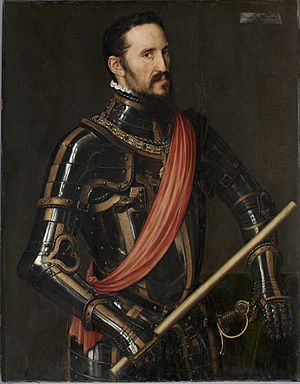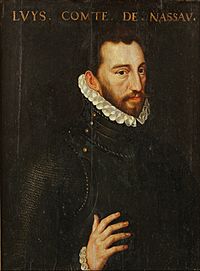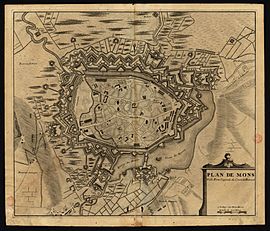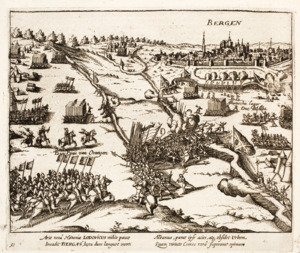Siege of Mons (1572) facts for kids
Quick facts for kids Siege of Mons (1572) |
|||||||
|---|---|---|---|---|---|---|---|
| Part of the Eighty Years' War and the Anglo-Spanish War (1585–1604) | |||||||
 Mons in 1572 by Frans Hogenberg |
|||||||
|
|||||||
| Belligerents | |||||||
| Commanders and leaders | |||||||
| Strength | |||||||
| Louis of Nassau: 6,000–6,500 men Jean de Hangest: 10,000 men William of Orange: 14,000 infantry and 3,000 cavalry |
8,500 36 cannons |
||||||
The Siege of Mons in 1572 was an important event during the Eighty Years' War. This war was a long fight for independence by the Dutch against Spanish rule. The siege happened in Mons, a city in what is now Belgium. It lasted from June 23 to September 19, 1572.
The conflict also involved the Anglo-Spanish War (1585–1604) and the French Wars of Religion. In the spring of 1572, a Protestant army led by Louis of Nassau captured the city of Valenciennes. Louis then surprised and took control of Mons on May 24.
After three months, Spanish forces led by the Duke of Alba defeated the armies trying to help Mons. With no hope of rescue, Louis of Nassau's troops in Mons surrendered to the Duke of Alba on September 19. This was a major victory for Spain.
Contents
Why Did the Siege of Mons Happen?
In May 1572, Louis of Nassau, a key leader of the Dutch rebels, was encouraged by a recent victory at Brielle. He also had support from Gaspard II de Coligny, a French Huguenot (French Protestant) leader. Louis invaded the Spanish Netherlands with an army of German, English, Scottish, and French soldiers.
On May 21, his forces captured Valenciennes. Two days later, Louis arrived at Mons with 1,000 foot soldiers and 500 horsemen. The next day, he learned how the city gates opened. Louis and his cavalry entered Mons by surprise, defeating the small Spanish group guarding it. Louis took control of the city. Soon after, he was joined by about 4,500 more soldiers led by the Count of Montgomery.
When Spain heard the news, Don Fernando Álvarez de Toledo, the Duke of Alba, who was the Spanish commander in the Low Countries, sent his son Don Fadrique with 4,000 soldiers to take Mons back. On June 23, Fadrique's army arrived and began the siege of Mons. The Duke of Alba also recaptured Valenciennes, which was a big loss for the rebels.
Meanwhile, William of Orange, Louis's brother, gathered an army of 14,000 foot soldiers and 3,000 horsemen in Germany. On July 7, William crossed the Rhine River and entered the Netherlands.
What Happened During the Siege?
Louis of Nassau knew his brother William was coming. He sent Jean de Hangest to France to get more help. In mid-July, Jean de Hangest returned with 10,000 men and marched towards Mons. Louis told Jean de Hangest to join William's army, but he ignored the message and advanced against the Spanish.
Battle of Saint-Ghislain
On July 19, Jean de Hangest's forces camped near Mons. Don Fadrique, knowing they were there, attacked with 4,000 foot soldiers, 1,500 horsemen, and 3,000 armed villagers. Jean de Hangest's scouts saw the Spanish coming and rushed back to their camp, shouting, "Don Frederic de Toledo is coming!"
The Spanish cavalry quickly charged the French army. This caused panic among the French Huguenots. The Spanish foot soldiers then completely defeated the French army. About 2,000 French soldiers were killed or wounded, and 700 were captured. Jean de Hangest, the French leader, was also captured and taken to Antwerp.
Meanwhile, William of Orange continued to move his new army towards Mons. On July 23, after capturing Roermond, his troops refused to fight because they hadn't been paid. On August 27, after getting promises of payment from some cities, William crossed the Meuse River. He continued to advance through several towns.
The St. Bartholomew's Day Massacre
On August 11, Gaspard II de Coligny had told William of Orange that he expected to march to the Netherlands soon. However, in France, King Charles IX became worried about a Spanish invasion and a Catholic uprising if he helped the Huguenots and Dutch Protestants.
This fear led to the terrible St. Bartholomew's Day massacre on August 23. Thousands of Huguenots were killed in France. When news of this reached the Netherlands, it greatly lowered the spirits of the Protestant troops, especially those with Louis of Nassau in Mons, as many were Huguenots. In the Spanish camp, however, people celebrated with bonfires and lights.
In early September, Don Fernando, the Duke of Alba, arrived at Mons with more soldiers and took command. Even though he was a strong Catholic, he called the massacre an "atrocity." William of Orange continued to advance, and some towns opened their gates to him out of fear. On September 10, William's army arrived near Mons.
William of Orange's Army Retreats


On September 10, William of Orange's cavalry attacked the side of the Spanish army. But Spanish arquebusiers (soldiers with early firearms), led by the Duke of Alba and his son, pushed them back. This caused many losses for William's cavalry. After this failed attack, William retreated to the village of Harmignies.
On the night of September 11, the Spanish commander Julian Romero led 600 arquebusiers into William of Orange's camp. They killed 600 rebels while only losing 60 of their own men. They captured many horses and destroyed supplies. William of Orange himself was sleeping deeply and was saved by his Spaniel dog, who barked and woke him up.
With a heavy heart, William wrote to his brother Louis that he could not help Mons. William then retreated with his army. Most of his troops, who had not been paid, left and went back to Germany. William himself went almost alone to Holland, the only area still loyal to him.
The Surrender of Mons
After the French Huguenot army was defeated and William of Orange's army left, Louis of Nassau was alone in Mons. Even the French Huguenots under his command rebelled because of the St. Bartholomew's Day massacre. On September 19, Louis of Nassau surrendered Mons to the Duke of Alba. They agreed on the terms for the city's surrender.
What Happened After the Siege?

Louis of Nassau met with the Duke of Alba and other Spanish leaders. The city was emptied on September 21, and the Duke of Alba entered Mons on September 24. Philip of Noircames, who was the Governor of Hainaut, took control of the city.
All the towns that had supported William of Orange, many out of fear, returned to Spanish rule under the Duke of Alba. However, Alba marched on Mechelen, a city that had helped William's army. To punish Mechelen and pay his soldiers, the Duke of Alba ordered his son Don Fadrique to sack the city, meaning his troops looted and destroyed it.
After dealing with William's threat in the south, Alba sent his son Don Fadrique to the two rebellious areas of Gelderland and Holland. Fadrique began his campaign by capturing the strong city of Zutphen. On his way to Amsterdam, Don Fadrique came across Naarden, which surrendered on November 22, 1572.
Long-Term Effects of the Siege
Losing Mons was a big setback for the Dutch rebels. They never again had a chance to get the support of the Protestants in the southern areas (called Walloon areas). The rebellion stayed mostly in the northern parts of the Netherlands.
Nine years later, Mons became part of the Union of Arras, which was a group of Catholic areas that accepted Spanish rule. Protestantism was then completely removed from Mons. So, the loss of Mons was an important step that led to the division of the Habsburg Netherlands into two separate parts. These two parts eventually became the countries we know today as the Netherlands and Belgium.
See also
 In Spanish: Asedio de Mons (1572) para niños
In Spanish: Asedio de Mons (1572) para niños



